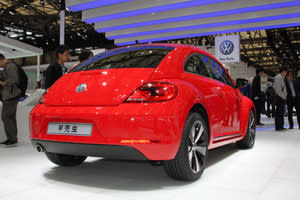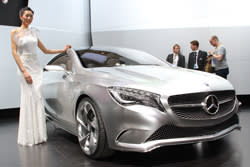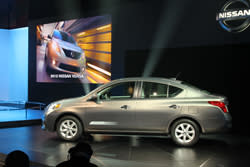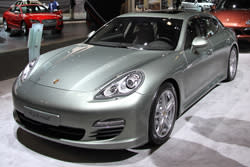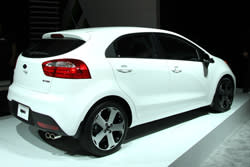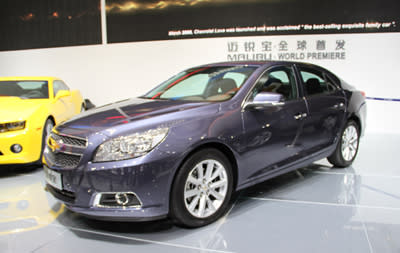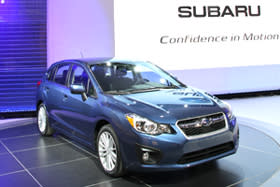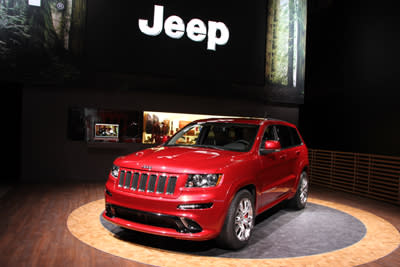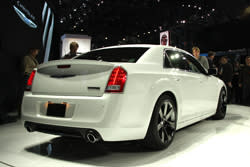Best of the 2011 New York & Shanghai Auto Shows
The latest in highly fuel efficient — and in some cases high-powered — production cars.
The automobile industry’s stars aligned to make this year’s New York and Shanghai auto shows open on the same week, and because of this overlap, several new models were introduced almost simultaneously on separate continents.
Shanghai showcased more concept cars, while New York focused mainly on production models. But with oil prices off the charts (the average price for unleaded gasoline in the U.S. is nearing $4 per gallon) the common theme was fuel economy -- and not just for small economy cars, as even Porsche premiered a new hybrid model. There were also five major compact car debuts, and several major updates to various compact and subcompact models.
Of course, a few manufacturers (Chrysler, Jeep, and Shelby, to name them) didn’t get the efficiency memo and debuted hot rods and over-the-top muscle cars, just to keep us guessing (and scratching our heads). But those were the exceptions to the rule.
Volkswagen sold 23 million original Beetles, and 6 million in the United States alone. As a testament to the global market, the 2012 Volkswagen Beetle was unveiled nearly simultaneously in New York and Shanghai, with a third appearance in Berlin.
Sales of the New Beetle had stalled in recent years, so VW went back to the drawing board for only the third redesign in the car's 73-year history. Klaus Bischoff, head of design for the Volkswagen brand, sums up the new design in one word: "Masculine."
Indeed, while the last Beetle skewed feminine with dash-mounted bud vases and a three-circle form, the new version aims to strike a different chord.
“We started from scratch,” Bischoff said. “We wanted to give it a whole new character, to make a dynamic, sportier, more masculine car.” The car eschews the three-circle simplicity of the outgoing model and its high roof. Instead, Bischoff looked back to the original Beetle, as designed by Ferdinand Porsche. “We had an original one in the studio,” he said. The hood of the new car is longer, the windshield moves rearward and rests at a lower angle, while overall width and length have increased. As a result, the car sports a hunkered-down appearance while remaining instantly recognizable as a Beetle.
The newfound machismo may come down to the 19-inch, 10-spoke wheels. “Big wheels are masculine,” Bischoff said. The interior also brings in exterior color in a similar fashion to the new Fiat 500 and Mini Cooper. The top-end TSI model is available with an XDS differential and traction control system. Luca De Meo, VW’s director of marketing says “it makes it sporty, like the Herbie in the movie." The standard engine will be a 2.5-liter, 170-hp four-cylinder and a 2-liter, 140-hp turbodiesel four-cylinder that gets between 29 and 40 mpg.
Carroll Shelby has not been satisfied in the horsepower department for all of his 88 years. Thus begat the latest beast to wear the Shelby name, the 2012 Shelby GT500 Super Snake unveiled at the New York Auto Show.
The Super Snake package includes a six-speed transmission with short-throw shifter, a Ford Racing handling package with adjustable shocks, special springs, anti-roll bars, a front strut tower brace, forged
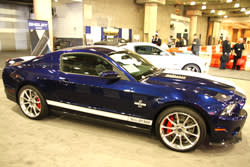
Shelby/Baer brakes with six-piston calipers, a 3.73:1 rear axle ratio, and a fiberglass hood like the 1967 GT500.
Shelby's been down the Super Snake road before, but this latest iteration is the most powerful. The standard package develops 550 hp from the supercharged 5.4-liter V8. The next stage brings that up to 750 hp. The final stage uses a supercharger to churn out an incredible 800 horsepower.
The base Super Snake package costs $34,245 on top of the $48,645 Ford Mustang Shelby GT500, for a total of $82,890.
Due to the tremendous costs, which can easily exceed $5 million per car, most automobile manufacturers build only one copy of any given concept car. Mercedes-Benz doubled down with its latest effort, the Mercedes-Benz Concept A-Class concept car, which premiered in both Shanghai and New York.
The A-Class will spawn four compact-platform Mercedes models over the next few years, says Dr. Joachim Schmidt, Mercedes-Benz's chief sales and marketing executive.
Mercedes says the car's power will come from a 2.0-liter, 210-hp four-cylinder engine with direct fuel injection via a dual-clutch transmission. Electric, hybrid, and high-performance AMG variations are planned.
“
Mercedes wants all the emotion attached to sports cars like SLS and SLK transferred to this small car segment," says Thomas Engl, chief engineer on the A-Class project. "This will attract younger customers we don’t have today in the [subcompact and compact] segments.”
The concept showcases Mercedes designers' love for short side glass, which is attractive, if impractical from a visibility standpoint.
Starting at $10,990, the Versa sedan is the least expensive car in America. On the heels of the Leaf electric vehicle, Nissan has given the 2012 Nissan Versa improved economy, lower emissions, and a surprising amount of interior room (Nissan claims more legroom than in the Lexus LS460, the BMW 5-Series and the Mercedes-Benz E-Class). A hatchback model will follow shortly after the summer launch of the sedan.
Nissan built the new Versa on a new global front-wheel-drive platform which, while similar in size to the one it replaces, weighs 150 pounds less. That means better efficiency and less power required to achieve the same performance.
“High gas prices have indeed shifted our focus and development away from trucks,” Carlos Tavares, Nissan's chairman of the Americas, said. “Oil prices may go even higher, so we plan [ahead] with products like the Versa,” Tavares said. The new Versa achieves better fuel economy than the outgoing model by 5 mpg.
The base Versa is equipped with standard air conditioning, stability control, antilock brakes with electronic brake-force distribution, and electronic power steering. Bluetooth, touch-screen navigation, satellite radio, and an iPod/USB interface are also available.
The new Versa’s 1.6-liter four-cylinder engine develops 109 hp, achieving 30 city mpg and 37 highway mpg (or 33 combined mpg, which Nissan says is a better representation of real-world results) with the continuously-variable automatic transmission. The five-speed manual returns an estimated 27/36 mpg city/highway. Nissan has deleted the previous 1.8-liter engine version of the Versa with this redesign.
All 2012 Nissan Versas will be offered in three trim levels; the S will be available with either a five-speed manual or CVT, while the SV and SL will be CVT-equipped only.
Porsche continues to expand its model range. Having shown the hybrid 918 supercar a year ago and currently offering the Cayenne Hybrid SUV, the company's second production hybrid is the Porsche Panamera Hybrid S.
“The feedback on our hybrid technology has been surprisingly positive,” said Detlef von Platen, Porsche Cars North America's CEO. “Customers understand that the performance they expect is there while being more efficient. Hybrid is a technology we’ve embraced because it's a strong alternative to improve performance and comply with more stringent upcoming fuel economy regulations.”
This combination of a supercharged, direct-injected 3.0-liter V-6 with an electric motor is also used in the Cayenne and Volkswagen Touareg Hybrid. Boosted by a 47-hp electric motor, 380 hp drives the rear wheels through an eight-speed automatic transmission.
Porsche claims the car can reach 60 mph in 5.7 seconds, which is not exactly slow, but not exactly fast for an “S” model Porsche. Top speed is 168 mph. The Panamera can accelerate up to 50 mph on electricity alone, although the range in this mode is just 1.3 miles. The car has not been EPA certified, so fuel economy figures are not yet available.
“You can disengage the engine from the transmission completely at speeds up to 103 mph,” von Platen said. The result is a drastic decrease in mechanical drag, so that maintaining high speeds requires less power and therefore less fuel. “In the end, you get the power and torque of the V8 Panamera S with the economy of a six-cylinder.”
The Panamera Hybrid enters the market while other luxury hybrid sedans have already launched, like the Mercedes-Benz S400 Hybrid with 295 hp, the BMW ActiveHybrid 750i/Li with 455 hp and the Lexus LS600hL with 438 hp. Though Porsche’s approach using a six-cylinder engine is similar to that of Mercedes, the Porsche can be propelled solely on electric power. However, with the goal being heightened efficiency, there is an unavoidable wrinkle. Diesel versions of each sedan (in the European market, not the U.S) return better fuel economy than the hybrid.
“We did consider using a diesel engine in the U.S. when we introduced the diesel in Europe some time ago, but the tax advantages for diesels are much more favorable in Europe,” says von Platen. “Also, the U.S. market was not ready in terms of perception. Today, those perceptions are much different. Diesel is much better thought of as a high-tech product, it is considered clean, and we are strongly considering it in the U.S., but we have not made a decision yet.”
“From another perspective, social acceptability is important to us. In a moment when the economy is bad, unemployment is high, and the mood in the environment for luxury products might not be as favorable as it might have been before, we strive to be mindful of that,” von Platen says. “We’re keen to keep the brand exclusive but also socially responsible. Clean, innovative technology and alternative propulsion development is one way an engineering-focused company like Porsche can express itself.”
For now, the Panamera S hybrid holds the green & efficient playing card in the Porsche deck and will open the bidding at $95,975, some $5,000 more dear than the Panamera S. It will hit showrooms this summer.
Hyundai is focused on fuel economy, but not necessarily with the aid of hybrid technology. Pure electric and other alternative fuels make cars like the Chevy Volt and Nissan Leaf “somewhat questionable as a mass-market solution,” according to John Krafcik, Hyundai's president and CEO. “Continued development of the conventional engine is the key to providing the biggest benefit to the customer.”
Indeed, Hyundai outsells the high-mileage, conventional-drive competition -- those vehicles that achieve 40 mpg -- by a 6-to-1 margin. In 2011, Hyundai estimates that 200,000 vehicles rated at 40 mpg will be sold, a that number will increase to 285,000 cars in 2012 (which is more cars than Mercedes-Benz sold in the U.S. -- in total -- in 2010).
The 2012 Hyundai Accent is one such car. It gets better fuel economy, delivers more power, more interior room, and a higher level of safety features than the previous model. The new Accent (available in both four- and five-door versions) uses a 138-hp, 1.6-liter, direct-fuel-injection four-cylinder engine. When it goes on sale in May, the new Accent will be priced at $12,445.
The Accent’s 40-mpg highway rating is possible by its ActiveECO system that modifies engine and transmission responses. Hyundai claims up to 7 percent greater real-world fuel economy with the function. With the upcoming new Accent, Hyundai will have four 40-mpg models that don’t rely on hybrid powertrains.

Using what Hyundai calls its "Fluidic Sculpture" design (also seen on the Elantra and Sonata models), the new Accent is slightly longer and wider than the outgoing Accent, providing more interior space for passengers. “Though it’s a subcompact, it's categorized as a compact car, one class up from the competition,” said Brandon Ramirez, the Accent’s product manager. “It has greater cargo capacity than an Infiniti EX35.”
Fuel economy drove the Accent’s redesign, but it wasn’t the only factor. “We got feedback from three-door owners that rear-seat access was a problem, so we decided to make a five-door hatchback and forego the three-door,” Ramirez said.
Vehicle stability control, traction control and antilock brakes with electronic brake-force distribution are all standard. The 2012 Hyundai Accent will hit showrooms this summer.
Hyundai also announced their “Hyundai Assurance Trade-In Value Guarantee.” The company promises to give customers a certain price for their now-new Hyundai when it’s returned for trade-in a few years away. Hyundai’s Krafcik says it’s “more car for your money now and more money for your car later.”
The 2012 Kia Rio five-door and four-door sedan models are slightly larger than last year's models, yet return 40+ mpg highway fuel economy through direct fuel injection and the first start-stop system in the subcompact class, which shuts off the engine when stationary, restarting it as the brake pedal is released.
The new Rio five-door goes on sale in November with the four-door sedan following in early 2012. Historically, Rio sales have skewed towards the sedan, but the 5-door version will compete with the Honda Fit, the new Nissan Versa, and the new Hyundai Accent (which shares its platform and engine).
The all-new chassis is joined by a new 1.6-liter, 138 hp engine with variable valve timing, plus six airbags and four-wheel disc brakes. Pricing has not been announced, but may increase due to the additional standard features.
“Rio has always gotten a lot of credit for value, safety and fuel economy,” says Tom Loveless, Hyundai's vice president of sales. “What was missing was an emotional connection with the car."
GM announced that it will launch the Eco mild hybrid version of its new 2013 Chevrolet Malibu sedan in the first quarter of 2012, going directly after the Toyota Camry Hybrid and Hyundai Sonata Hybrid. Shortly thereafter, Chevy will launch the conventional 2.5-liter Malibu models.
The new Malibu features sporty cues with its high rear, sizable integrated rear spoiler, and a wider track.
“There’s a definite Camaro influence in body side surfaces with broader shoulders and an athletic appearance,” Bryan Nesbitt, GM’s executive director of exterior design. Dual tail lights frame the rear of the car and recall Malibus and Camaros of years ago.
“We wanted to change its persona to make it much more sporty, but what’s equally gratifying is setting -- and meeting -- very aggressive goals for aerodynamic efficiency," Nesbitt said. "The final wind tunnel testing shows that Malibu is right near the Chevy Volt in aero numbers, and that’s our most aerodynamic sedan ever.”
Chevy will sell this Malibu in global markets including Asia and Europe, and therefore various different regulatory factors were considered early on.
Conventional Malibus use the new 2.5-liter, 190-hp four-cylinder engine while the Eco gets the 2.4-liter, 180-hp four-cylinder coupled to a mild hybrid system with a lithium-ion battery. Chevy expects between 26 and 38 mpg, whereas the 2011 Toyota Camry Hybrid achieves between 31 and 35 mpg, and the 2011 Hyundai Sonata Hybrid yields between 35 and 40 mpg.
The Impreza has provided the entry point for Subaru ownership for almost 20 years and has played a pivotal role in the growing success of the brand in the U.S. market. Also notable is that the Impreza is high in value, long in durability, and provides the foundation on which the rally-inspired WRX and WRX STI have won over legions of rally fans.
Which is why the all-new 2012 Subaru Impreza is a bit of a surprise. The appearance is somewhat busy with “hawk-eye” headlights, a prominent chin, and a Legacy-inspired grille that doesn’t quite fit the smaller Impreza’s fascia and bulging fenders. Compared to designs coming out of Kia, Hyundai, even Chevrolet, the Impreza is trailing the competition.
The wheelbase is slightly longer than last year's model, but the rest of the car’s exterior dimensions remain effectively the same. There’s more cargo capacity and less weight.
Base, Premium, and Limited trim levels will be available.
The natural trend in engine evolution is slightly larger, slightly more powerful year after year. The 2012 Impreza bucks this trend, getting a new smaller engine with 22 fewer horsepower (from 170 to 148). The upside, however, is that the new Impreza takes a 30-percent leap forward in fuel economy. Coupled to its CVT automatic, the 2012 Impreza yields between 27 and 36 mpg. (The five-speed is rated at 25/34 city.highway compared to the previous 20/27.) This is all underpinned by a proven all-wheel-drive chassis that’s standard on this and every Subaru and essentially unavailable from other subcompacts in the Impreza’s class.
With less power, less weight, and better efficiency, the 2012 Impreza will no doubt do well, if you can get past the looks department. The Impreza's beauty is definitely beneath the skin.
Jeep’s lineup went SRT8-less for a year in the Grand Cherokee lineup as the old model made room for the new one, but the sabbatical ends this summer. Chrysler unveiled the 2012 Jeep Grand Cherokee SRT8 in New York, calling it the "most powerful Jeep vehicle ever."
The 2012 SRT8’s 465 hp, 6.4-liter Hemi V8 engine picks up where the 2010 Grand Cherokee SRT8’s 425-hp, 6.1-liter Hemi V8 engine left off. Via a five-speed automatic transmission, the new Grand Cherokee SRT8 will go from zero to 60 mph in 4.8 seconds -- thanks to tenacious traction -- and accelerates to an electronically-limited top speed of 155 mph.
Chrysler does not yet have fuel economy estimates on the SRT8, but it’s safe to say it's nothing like a Toyota Prius.
Inside, the SRT8’s race-inspired cockpit offers the driver steering-wheel-mounted paddles to shift the transmission manually, and displays performance stats in the center console. The cabin also gets a leather-wrapped heated steering wheel, carbon-fiber trim and leather-and-suede seats. An 825-watt sound system will pump out the most bombastic Wagner or White Stripes.
Oddly, the previous-generation SRT8 Grand Cherokee was not rated for towing. No longer. The new SRT8 can haul 5,000 pounds.
Chassis highlights include a new SRT-tuned suspension with adaptive damping, Brembo brakes and new split-five-spoke 20-inch forged aluminum wheels. SRT8s ride one inch lower than standard models and receive body-color fender flares, side cladding, and a dual-sport exhaust system with huge 4-inch exhaust tips.
Scared of full throttle or winding around the back roads with this much “go” on tap? Jeep will throw in one day of professional driving instruction from the Richard Petty Driving School when you purchase one!
The recently redesigned Chrysler 300 is now joined by a fortified 2012 Chrysler 300 SRT8 high-performance stud with 6.4-liters of roaring Hemi V8 making 465 horsepower and 465 ft-lbs of torque (an increase of 40 hp). Aerodynamics and bodywork are uniquely tucked and tuned, too. Pricing has not been officially announced, but should start around $45,000.
“The Chrysler 300 SRT8 is no-compromises, king-of-the-hill, the ultimate combination of world-class luxury and performance, in our most powerful, best-handling sedan ever,” said Olivier François, Chrysler’s president and chief executive.
The latest 300 debuted last fall and garnered plenty of accolades, though there was a hole in the lineup where the old SRT8 model stood. The new 300 SRT8 can reach 60 mph in the 4-second range and, with a full head of steam, reach 175 mph. Not to be pigeonholed as only a taker, the SRT8’s fuel economy should be improved 25 percent thanks to a cylinder deactivation program that shuts down four of the eight cylinders.
Unique, lightweight 20-inch wheels in a menacing black finish partially hide huge brake discs and racing-derived Brembo calipers. The SRT Group within Chrysler has adopted a benchmark performance test that goes back over 40 years to racing and test driver, Ken Miles, then in the employ of Carroll Shelby. Miles reckoned braking was every bit as important as acceleration and devised an exercise of racing to 100 mph and immediately throwing out anchor to stop the car as rapidly as possible. Thus, the 0-100-0 mph measurement was born. The SRT Group’s braking system enables the SRT8 to do the 0-100-0 mph run in under 16 seconds and go from 60-0 mph in just 120 feet.
Across the front, the SRT8 has a new lower fascia and a unique slotted grill that's echoed in the lower fascia openings. New sills lower the car visually, and the trunk lid sprouts a subtle spoiler. Inside, the SRT8 is leather-lined and swathed in racy carbon fiber. The large touchscreen offers Performance Pages, which displays performance data like horsepower output, torque output, and cornering forces, and can tabulate zero-to-60 acceleration, 60-to-zero braking, and standing quarter-mile elapsed times.
Steering wheel-mounted paddle shifters have been added, and allow manual operation of the five-speed automatic transmission. Also, adaptive dampening shocks allow either a smoother or more athletic setting of the suspension. Seven-spoke, 20-inch forged aluminum wheels wrapped in beefy tires meet the road.
For those who want to get their Lightning McQueen on, Chrysler offers a free day of driver training at the Richard Petty Driving School for SRT owners.

 Yahoo Autos
Yahoo Autos 
